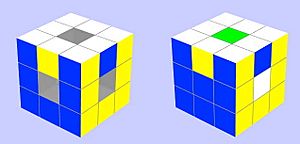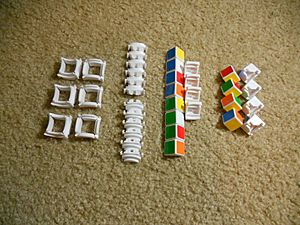Void Cube facts for kids
The Void Cube is a cool mechanical puzzle that looks a lot like a Rubik's Cube. But there's a big difference! The Void Cube has no center pieces, which means you can see right through it. It even looks a bit like a level 1 Menger sponge, which is a special kind of fractal shape.
Because there are no center pieces, the Void Cube also doesn't have the usual core found in a Rubik's Cube. This creates holes that go straight through the puzzle in every direction. Even though it looks different inside, you can still make the same kinds of moves as a regular Rubik's Cube. The Void Cube was invented by Katsuhiko Okamoto. A company in Japan called Gentosha Education makes and sells them.
Solving the Void Cube
Solving the Void Cube can be a bit trickier than a regular Rubik's Cube. This is because of something called parity. Don't worry, it's not too complicated!
When you turn a face on a regular Rubik's Cube, it moves eight pieces around. This is an "even" type of move. If you turn the whole regular cube, it also moves pieces in an "even" way.
But on the Void Cube, things are different. When you turn a whole Void Cube, it moves 20 pieces. This kind of move is considered an "odd" type of move.
What does this mean for you? It means that on a Void Cube, you might end up in a situation where just two pieces are swapped, and everything else is in the right place. This kind of swap can't happen on a regular Rubik's Cube! It's an extra challenge that makes the Void Cube unique. Luckily, there are simple steps you can learn to fix these "odd" situations.
Imagine a regular Rubik's Cube is solved when all the colors on the edge and corner pieces match the center pieces. For a Void Cube, it's solved when the edge and corner pieces match each other. You don't have center pieces to guide you. This can lead to "cat's eye" patterns where the colors line up nicely, even without centers.
How the Void Cube Works Inside
The Void Cube has a clever design that lets it move without a central core. Here are the main parts:
- 20 colorful pieces:
- 8 corner pieces (these have three colors)
- 12 edge pieces (these have two colors)
- 6 internal support pieces: These are the pieces with the square holes that you can see through.
- 12 hidden sliding pieces: These are inside and help everything move smoothly.
The main structure of the Void Cube is made from those six internal support pieces. They fit together like the sides of an invisible cube inside the puzzle. Each of these pieces has a square hole in the middle.
If you look closely at one of these support pieces, you'll see it has a curved shape, like a low arch. This arch connects to the hidden sliding pieces. The top part of the arch has curved edges called "flanges." These flanges fit into grooves inside the colorful corner and edge pieces, holding the whole puzzle together.
When the Void Cube is solved and all its faces are lined up, these six support pieces can rotate freely. When you turn a face, the support piece behind that face also turns with the colorful pieces. The flanges on this support piece stay connected to the colorful pieces.
What keeps the colorful pieces from falling off when you turn a face? It's the flanges from the neighboring support pieces. The grooves inside the edge pieces fit over these flanges, keeping them in place as they move.
There are also 12 hidden sliding pieces. These pieces have a special shape that acts like a wedge. They help keep the main square support pieces spaced correctly. This spacing is important because it makes sure the grooves in the colorful pieces stay connected to the flanges. Good manufacturing makes sure the puzzle moves easily but doesn't fall apart.
The colorful edge pieces sit on small bumps on these hidden sliding pieces. So, when you turn a face, the edge pieces push the sliding pieces around in a circle. These sliding pieces, in turn, help rotate the main square support piece for that face.
The square support pieces also make sure the hidden sliding pieces stay in the right spot, close to the edges of the puzzle.
When a face is turned, the flanges on the support pieces temporarily hold the colorful pieces. For example, when you turn a face about halfway (45 degrees), the corner pieces are held by the curved flanges on the neighboring support pieces. As you keep turning, the different flanges take turns holding the pieces, guiding them along their circular path.



